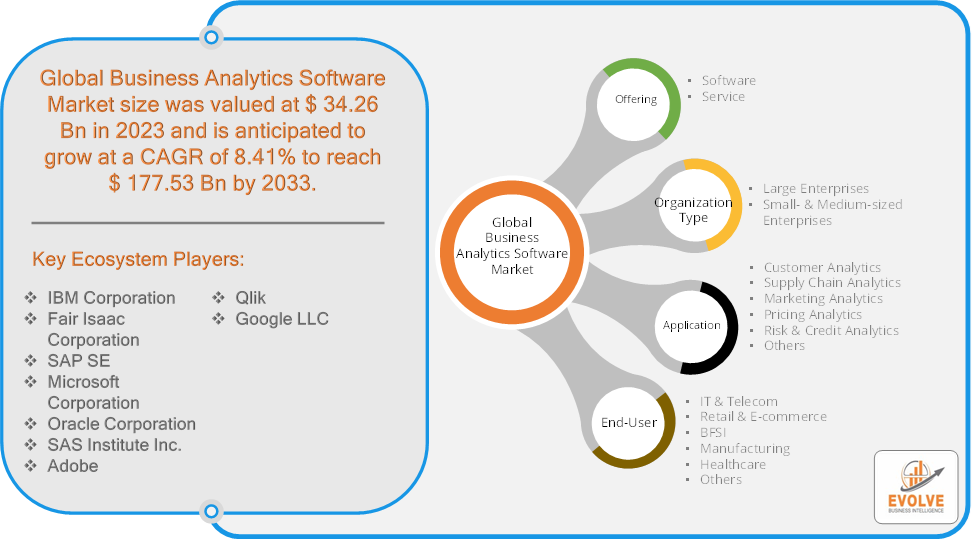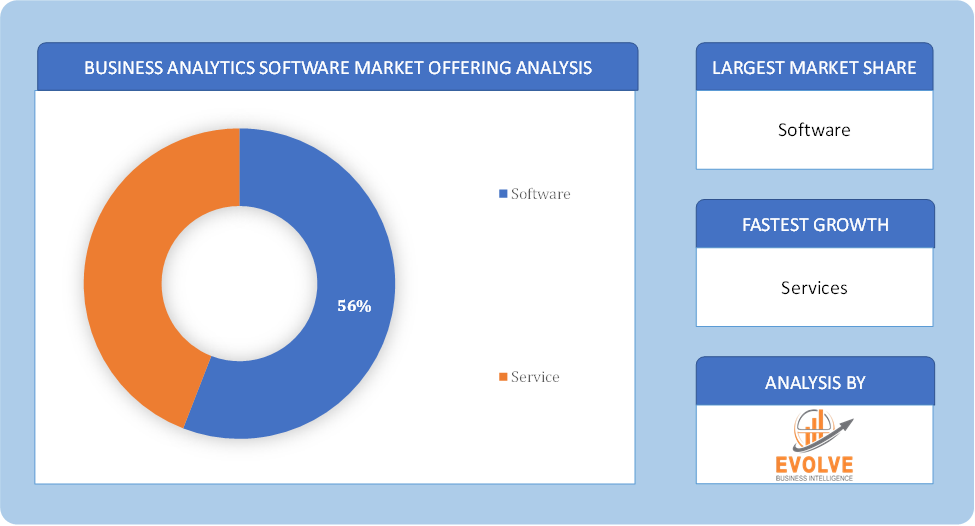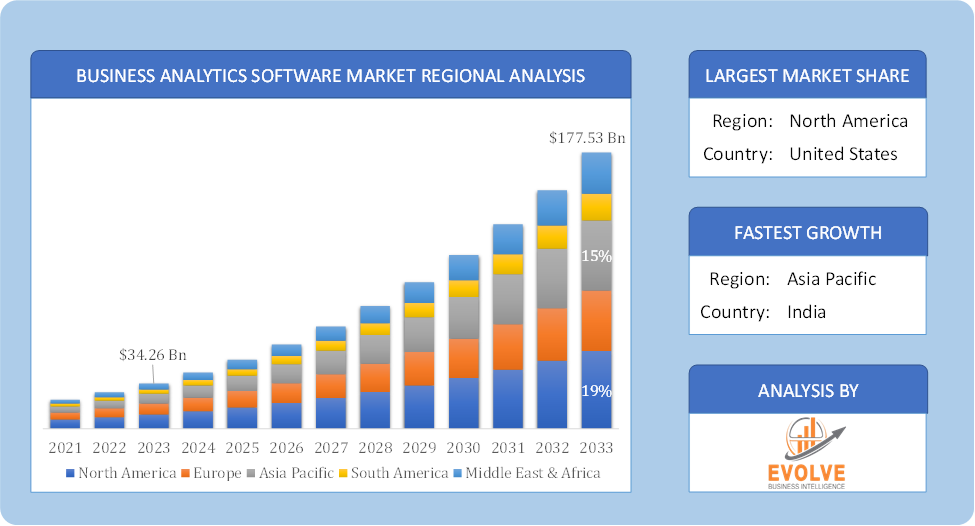Business Analytics Software Market Overview
The Business Analytics Software Market Size is expected to reach USD 177.53 Billion by 2033. The Business Analytics Software Market industry size accounted for USD 34.26 Billion in 2023 and is expected to expand at a compound annual growth rate (CAGR) of 8.41% from 2023 to 2033. The Business Analytics Software Market refers to the industry segment that encompasses software solutions designed to analyze business data and extract actionable insights. These software tools help organizations make data-driven decisions by processing large volumes of data, identifying patterns, predicting trends, and generating reports.
The Business Analytics Software Market is expected to grow significantly as more businesses across various industries recognize the value of data in driving strategic decisions and improving operational efficiency.
Global Business Analytics Software Market Synopsis
The COVID-19 pandemic had a significant impact on the Business Analytics Software Market. The pandemic accelerated the adoption of digital and analytics tools as organizations sought to adapt to remote work, changing market conditions, and supply chain disruptions. Business analytics software became crucial for real-time data analysis and decision-making. Companies needed to make swift, data-driven decisions to navigate the uncertainties brought by the pandemic. This increased the demand for business analytics tools to provide actionable insights and forecasts. The increase in data collection and analysis raised concerns about data privacy and security, prompting companies to focus on compliance and protection measures. The pandemic highlighted the importance of agility and resilience, leading to greater interest in predictive and prescriptive analytics to better prepare for future uncertainties.
Business Analytics Software Market Dynamics
The major factors that have impacted the growth of Business Analytics Software Market are as follows:
Drivers:
Ø Technological Advancements
Integration of artificial intelligence (AI) and machine learning enhances the capabilities of business analytics software, enabling more accurate predictions, trend analysis, and automation of repetitive tasks. The adoption of cloud-based solutions offers scalability, flexibility, and cost-effectiveness, making advanced analytics tools more accessible to businesses of all sizes. Organizations are using business analytics to identify cost-saving opportunities, streamline processes, and improve overall efficiency, driving demand for analytics tools. Businesses seek to monitor and enhance performance metrics, requiring robust analytics solutions to track key performance indicators (KPIs) and outcomes.
Restraint:
- Perception of High Costs and System Compatibility
The initial cost of acquiring and implementing business analytics software, along with ongoing maintenance and support expenses, can be high, especially for small and medium-sized enterprises (SMEs). Advanced analytics tools can require significant investment in terms of both financial resources and skilled personnel. Integrating new analytics tools with existing IT systems and data sources can be complex and time-consuming, potentially leading to delays and increased costs. Organizations with fragmented data systems may face difficulties in consolidating and analyzing data effectively.
Opportunity:
⮚ Enhanced Data Visualization and User Experience
Advanced data visualization tools and interactive dashboards can improve user experience and accessibility, making it easier for users to interpret and act on data insights. Developing more intuitive and user-friendly interfaces can increase adoption and utilization across different business functions. The demand for real-time analytics is growing as businesses seek immediate insights to respond quickly to market changes and operational challenges. Leveraging data from Internet of Things (IoT) devices for real-time monitoring and analytics presents new opportunities for innovation.
Business Analytics Software Market Segment Overview
Based on Offering, the market is segmented based on Software and Service. The software segment dominant the market. This is due to a rise in the use of business analytics software by businesses in order to acquire a strategic and competitive advantage over the competitors. Furthermore, it assists them in making rapid and educated judgments by analyzing business data, which fosters market growth.
By Organization Size
Based on Organization Size, the market segment has been divided into Large Enterprises and Small- & Medium-sized Enterprises. The small and medium size enterprises segment dominant the market due to the increasing accessibility and affordability of analytics tools and solutions. Many software providers now offer cloud-based analytics services with subscription models, making it cost-effective for SMEs to access powerful analytics capabilities without substantial upfront investments.
By Application
Based on Application, the market segment has been divided into Customer Analytics, Supply Chain Analytics, Marketing Analytics, Pricing Analytics, Risk & Credit Analytics and Others. The customer analytics segment dominant the business analytics software. The major factors behind this were the growth in consumer behavior analytics trends and increase in competitiveness of the modern business world.
By End User
Based on End Users, the market segment has been divided into IT & Telecom, Retail & E-commerce, BFSI, Manufacturing, Healthcare and Others. The BFSI segment dominant the market. The BFSI category generated the most income (70.4%) due to the continuous adoption of advanced analytics for optimizing processes, identifying fraudulent transactions, and handling data risks. However, telecom & IT is the fastest-growing category due to the growing demand for collaboration devices such as web and video conferencing.
Global Business Analytics Software Market Regional Analysis
Based on region, the global Business Analytics Software Market has been divided into North America, Europe, Asia-Pacific, the Middle East & Africa, and Latin America. North America is projected to dominate the use of the Business Analytics Software Market followed by the Asia-Pacific and Europe regions.
 Business Analytics Software North America Market
Business Analytics Software North America Market
North America holds a dominant position in the Business Analytics Software Market. North America, particularly the United States and Canada, is a leading market for business analytics software, driven by the presence of major technology companies, advanced infrastructure, and a high level of technology adoption. The region is a hub for innovation, with a strong focus on integrating AI, machine learning, and advanced analytics into business solutions and large enterprises across various sectors invest heavily in business analytics to enhance decision-making, optimize operations, and gain a competitive edge.
Business Analytics Software Asia-Pacific Market
The Asia-Pacific region has indeed emerged as the fastest-growing market for the Business Analytics Software Market industry. The Asia-Pacific region is witnessing rapid growth in the business analytics software market due to increasing digitalization, rising data volumes, and growing adoption of advanced technologies and countries like China, India, and Japan are major contributors to market growth. China and India, in particular, are expanding their digital infrastructure and investing in analytics to support economic growth.
Competitive Landscape
The global Business Analytics Software Market is highly competitive, with numerous players offering a wide range of software solutions. The competitive landscape is characterized by the presence of established companies, as well as emerging startups and niche players. To increase their market position and attract a wide consumer base, the businesses are employing various strategies, such as product launches, and strategic alliances.
Prominent Players:
- IBM Corporation
- Fair Isaac Corporation
- SAP SE
- Microsoft Corporation
- Oracle Corporation
- SAS Institute Inc.
- Adobe
- Qlik
- Google LLC
Key Development
In March 2023, Tibco Software Inc. announced a series of enhancements to its analytics suite that delivers immersive, smart, and real-time analytics and empowers customers to take action and benefit from faster, smarter insights.
In September 2023, SAP SE declared the development of the first software-based enterprise resource planning (ERP) system, that has changed the face of business and the ability of our customers to deliver value.
Scope of the Report
Global Business Analytics Software Market, by Offering
- Software
- Service
Global Business Analytics Software Market, by Organization Type
- Large Enterprises
- Small- & Medium-sized Enterprises.
Global Business Analytics Software Market, by Application
- Customer Analytics
- Supply Chain Analytics
- Marketing Analytics
- Pricing Analytics
- Risk & Credit Analytics
Global Business Analytics Software Market, by End user
- IT & Telecom
- Retail & E-commerce
- BFSI
- Manufacturing
- Healthcare
Global Business Analytics Software Market, by Region
- North America
- US
- Canada
- Mexico
- Europe
- UK
- Germany
- France
- Italy
- Spain
- Benelux
- Nordic
- Rest of Europe
- Asia Pacific
- China
- Japan
- South Korea
- Indonesia
- Austalia
- Malaysia
- India
- Rest of Asia Pacific
- South America
- Brazil
- Argentina
- Rest of South America
- Middle East & Africa
- Saudi Arabia
- UAE
- Egypt
- South Africa
- Rest of Middle East & Africa
| Parameters | Indicators |
|---|---|
| Market Size | 2033: USD 177.53 Billion |
| CAGR (2023-2033) | 8.41% |
| Base year | 2022 |
| Forecast Period | 2023-2033 |
| Historical Data | 2021 (2017 to 2020 On Demand) |
| Report Coverage | Revenue Forecast, Competitive Landscape, Growth Factors, and Trends |
| Key Segmentations | Offering, Organization Type, Application, End User |
| Geographies Covered | North America, Europe, Asia-Pacific, South America, Middle East, Africa |
| Key Vendors | IBM Corporation, Fair Isaac Corporation, SAP SE, Microsoft Corporation, Oracle Corporation, SAS Institute Inc., Adobe, Qlik and Google LLC |
| Key Market Opportunities | · Enhanced Data Visualization and User Experience · Focus on Real-Time Analytics |
| Key Market Drivers | · Technological Advancements · Need for Operational Efficiency |
REPORT CONTENT BRIEF:
- High-level analysis of the current and future Business Analytics Software Market trends and opportunities
- Detailed analysis of current market drivers, restraining factors, and opportunities in the future
- Business Analytics Software Market historical market size for the year 2021, and forecast from 2023 to 2033
- Business Analytics Software Market share analysis at each product level
- Competitor analysis with detailed insight into its product segment, Government & Defense strength, and strategies adopted.
- Identifies key strategies adopted including product launches and developments, mergers and acquisitions, joint ventures, collaborations, and partnerships as well as funding taken and investment done, among others.
- To identify and understand the various factors involved in the global Business Analytics Software Market affected by the pandemic
- To provide a detailed insight into the major companies operating in the market. The profiling will include the Government & Defense health of the company’s past 2-3 years with segmental and regional revenue breakup, product offering, recent developments, SWOT analysis, and key strategies.








